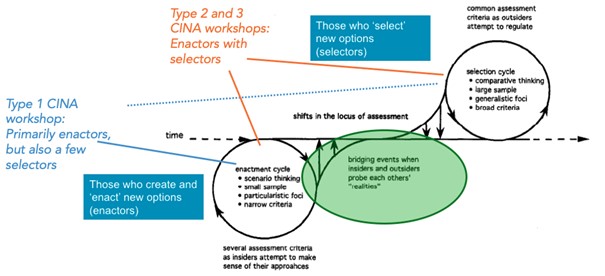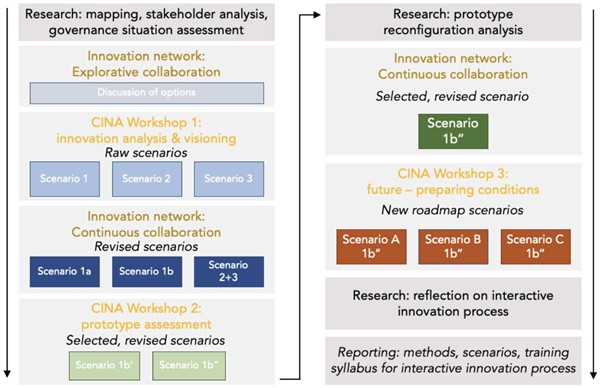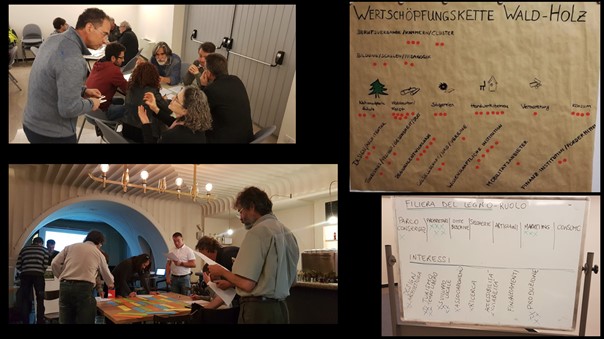AIM
In order to foster constructive stakeholder interaction along innovation journeys as well as a critical stance with regard to what is possible, we have developed the Constructive Innovation Assessment (CINA) approach with partners in various projects across Europe. The primary aim was to support innovation processes. CINA has become the backbone of the overall project-wide process in the project InnoForESt (see below for more detail). It transfers the rather selective one-off approach of Constructive Technology Assessment (CTA) (Rip, 2018 ) into a procedural approach that provides for three formats for successive and building-up interaction occasions: (1) the development of an idea of what the core of the innovation should be, (2) the review and improvement of a prototype of innovation that then emerges, and finally (3) the look beyond the end of the project to see how it can continue (Aukes et al., 2020, 2021). In all three cases, alternative scenarios are used (we will explain what these are in detail in the next sections). The three formats represent a consistent structure that is intended to ensure that all relevant stakeholders are intensively and extensively involved at strategically important decision-making points along the process. One or more workshops are usually held for each format. In-between workshops there is a wide variety of interactions with stakeholders that deal with details. The inclusion is more than just an alibi―the stakeholders should provide the basic inputs and gradually take control of the action. The CINA agents assist. The local change agents moderate.

Figure 1: CINA workshops in innovation context (cf. Garud & Ahlstrom 1997; Rip 2012)
The utility of CINA is both practical and scientific. On the one hand, it is well suited to structure innovation processes in practice and to support the further development of a respective innovation idea. On the other hand, it is an entry point for investigating how innovation processes work, in this case in the forest and environmental field. First, the approach requires thorough research into the innovation situation. Second, the innovation work in the overarching project context requires a degree of documentation that not only allows each other to inform each other about the regional efforts within the overall project, but also enables the respective innovation work to be reproduced. Thirdly, the ongoing assistance of the regional projects gains a lot of insights and knowledge through the close exchange and can thus observe the innovations in implementation very well. With this method, you can research what is happening in the project and in the regions. This allows for an accompanying reflection and learning in the process.
CINA For the innoforest project
In the InnoForESt project (EU Horizon 2020), the task of the Constructive Innovation Assessment (CINA) was to systematically transfer strategic knowledge into the innovation processes. For this purpose, narrative, sometimes rather tabular scenarios were developed linking stakeholder interests, innovation options, and respective governance situations. The aim was to formulate realistic and contextualised innovation options, including the key areas of tension that an innovation has to deal with.

Figure 2: CINA process and scenario development
But it could/did not stop there, because stakeholders are the linchpin of all efforts: They must be able and willing to do something with these ideas. The innovation work was designed in such a way that the scenarios were developed, stabilised or modified and sometimes sorted out (abandoned) together with the stakeholders at key points during intensive workshops that lasted the entire duration of the project. Working with the CINA approach is not an end in itself, but is closely related to the respective situation in a region and the ability to engage stakeholders in such a way that practical work on an innovation is possible. The CINA process was directly interwoven with the forest ecosystem governance of a region.

Figure 3: CINA workshops in the InnoForESt project
Participation in the InnoForESt project was not just/limited to a series of workshops, but encompassed various forms of communication and interaction. For the partners in the regions, participation in the InnoForESt project was also a practical challenge: to be self-confident and true to themselves and their own competences, but at the same time to be open to try something new. For them, CINA was not only part of a broader process, but also a method. This method seemed unwieldy at first, but gained momentum and attractiveness in the course of engaging with it. The effort involved in introducing and supporting CINA is substantial. If one does not want to return to a simple, linear illusion of ‘controllable’ innovation, then it is worth investing in support work with regional partners. All sides learn from it.

Figure 4: Foci and types of CINA workshops
LITERATURE
Aukes, E., Stegmaier, P., & Schleyer, C. (2021). Assisting in modulating FES governance: Constructive Innovation Assessment (in preparation). Ecosystem Services.
Aukes, Ewert, Peter Stegmaier, und Christian Schleyer. 2020a. Ecosystem Services Governance Navigator & Manual for its Use. InnoForESt Deliverable 5.5. https://innoforest.eu/repository/d5-5/.
Aukes, Ewert, Peter Stegmaier, und Christian Schleyer. 2020b. Final report on CINA workshops for ecosystem service governance innovations: Lessons learned. InnoForESt Deliverable 5.3. https://innoforest.eu/repository/d5-3/.
Aukes, Ewert, Peter Stegmaier, und Christian Schleyer. 2020c. Set of reports on CINA workshop findings in case study regions, compiled for ongoing co-design and knowledge exchange. InnoForESt Deliverable 4.2. https://innoforest.eu/repository/d4-2-overview/.
Stegmaier, P. (2020). Constructive Technology Assessment (CTA): Innovationsmitgestaltung als Prozess gesellschaftlicher Aufklärung und Erwartungsmoderation. In B. Blättel-Mink, I. Schulz-Schaeffer, & A. Windeler (Eds.), Handbuch Innovationsforschung (pp. 1-18). Wiesbaden: Springer VS. (This chapter will be translated with the entire handbook.)
